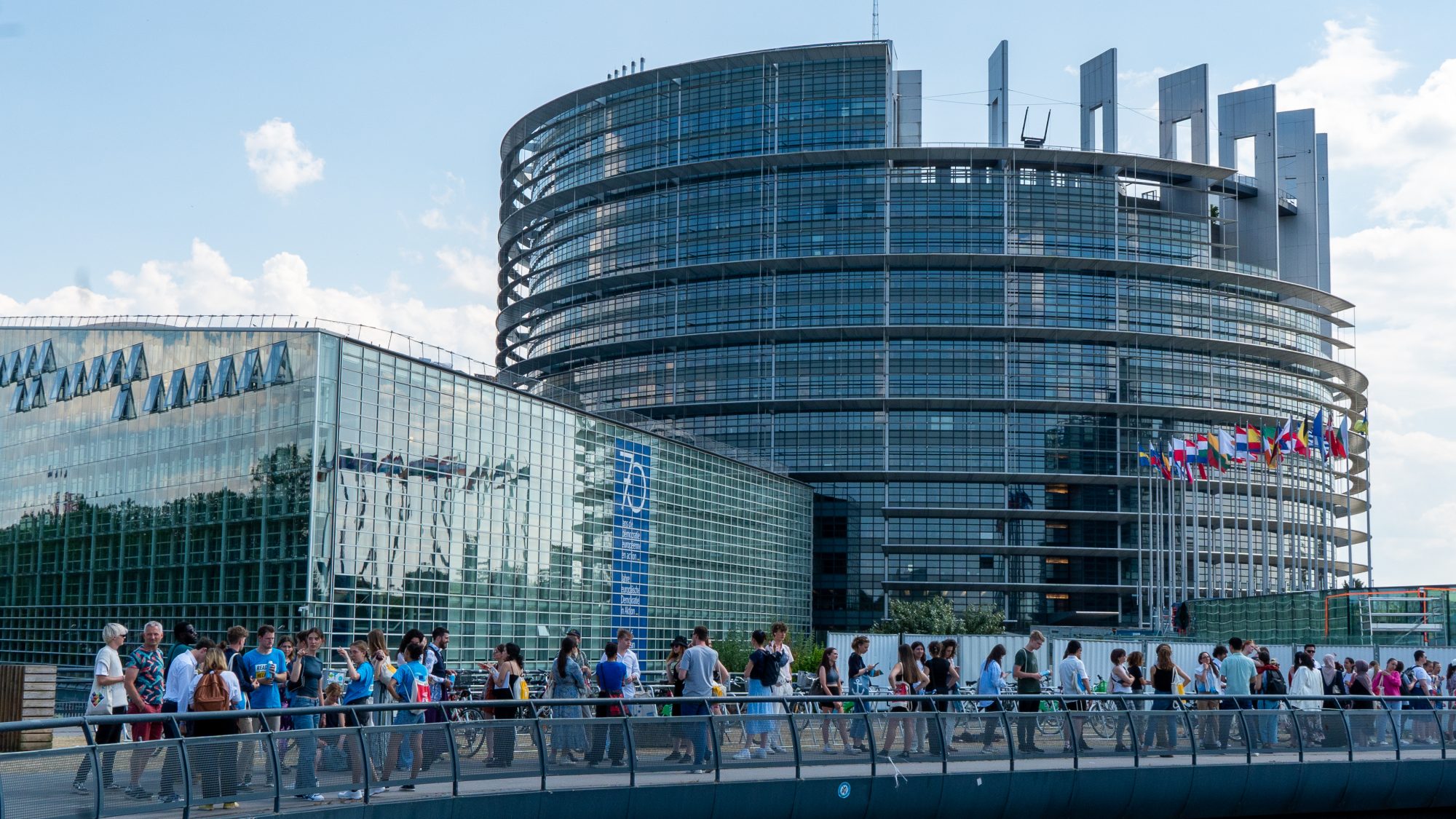
Title: Clarifying the Theory and Practice of European Populism with Dr. Pauliina Patana
A specter is haunting Europe–the specter of populism. Populist movements, particularly those associated with the radical right, have surged across the continent. Examples include the newfound success of the AfD in Germany and the recent electoral upsets of Geert Wilders in the Netherlands and Robert Fico in Slovakia. Populism is already having vast implications on policy outcomes at a time when conflict rages on in Ukraine and Israel, and Europe faces crises relating to energy, climate, immigration, and EU integration. Now, with elections coming down the pipeline across the continent in 2024–perhaps none more notable than the European Parliament elections–it is crucial to understand the apparent populist moment and what it means for regional outcomes going forward. To do so, GJIA is thrilled to speak with Dr. Pauliina Patana, a professor at Georgetown University and expert on the intersection of political behavior, political economy, and party politics, whose research focuses on the success of populist radical-right parties in Western Europe.
GJIA: In political discourse, “populism” has become somewhat of a loaded term thrown around by actors on all sides of the political spectrum. How does scholarly literature define “populism” in theory, and what characteristics typify it in contemporary practice in Europe?
PP: There is a lot of disagreement on how we should define populism. As you said, today the term is often thrown around to describe anything you disagree with. Thus, the term has lost a lot of its analytical value in that sense. In general, though, there are three key ways to theorize populism in political science. These include thinking about populism as a (1) political strategy, (2) a political ideology, or (3) a sociocultural approach. Different definitions are actually born from different regional contexts within which populism is observed. In the Latin American context, for example, scholars tend to think about populism as a political strategy, whereas in Europe, it is more seen as a political ideology.
I tend to fall into the ideology camp myself. If you see populism as a political ideology, it is often viewed as a “thin” one, which attaches itself to more “thick” ideologies, such as nationalism or nativism. According to this ideational approach, the core characteristic of populism is that it views society as divided into two homogenous and antagonistic groups. On the one hand, you have the “pure” people; on the other hand, you have the “corrupt” elite. This distinction is a moral one above anything else. Following from this, populists believe that politics should first and foremost be the expression of the general will of the “poor” people, and nothing else.
GJIA: How do you characterize the state of populism in Europe today? Are we experiencing a populist resurgence at a continent-wide level, and if so, what trends explain this?
PP: When it comes to the state of populism in Europe, you could say that it does very much appear to be thriving or at least has become part of the mainstream political arena rather than being relegated to the margin like it used to be for much of its prior existence. Populist, radical anti-establishment actors have performed very well in recent elections, whether in the Netherlands, Finland, Sweden, Southern Europe, or Eastern Europe, where actors like Robert Fico in Slovakia have recently won elections. Even when these parties have not necessarily won elections, they can still have a meaningful impact on how politics are conducted and conceived across Europe.
I would note here that the political developments in these countries are better defined as the resurgence of the radical right rather than the resurgence of populism. Again, these parties and political actors are best defined by their “thick” ideologies like nativism, xenophobia, and nationalism, rather than their populist nature, which isn’t necessarily the most important factor when considering their performance.
Overall, the rise of the radical right populist parties is deeply connected to the broader economic and social changes that we have seen across post-industrial societies. Of course, the economic, social, and geopolitical turmoil that the Ukraine-Russia war has generated has served these parties, which have been able to capitalize on different facets of this crisis, such as the economic consequences of rising electricity prices or the fatigue from accommodating Ukrainian refugees. These can partly explain their recent successes. There is something [distinctive] about this moment–but I wouldn’t characterize it as a unique resurgence. Rather, these parties have substantial leverage and have become more normalized.
GJIA: Your research has analyzed an interesting phenomenon at the subnational level: communities that support radical-right populist parties are often detached from the effects of immigration and globalization, issues which these parties capitalize on. How do you explain this phenomenon, and in what countries have we seen this occur?
PP: Indeed, a key focus of my research touches on these localities where support for populism is the highest. Yet, things have not changed in the sense we tend to associate with the rise of right-wing populism. These are not the structurally deprived, de-industrialized, or ethnically diverse areas that we [typically] think of as hotbeds for right-wing populism: rather, they are often rural areas that are ethnically homogenous and without much unemployment. A lot of this phenomenon has to do with the broader effects of post-industrialization and the transition into the contemporary knowledge economy, which has increasingly concentrated wealth in larger urban agglomerations. In these rural communities, things may not necessarily be declining, but individuals feel like the subjective status of their localities is declining, as they have a harder time accessing economic opportunities or public services than in the past. These are what I call “relative grievances,” where there is a cultural perception of a decline in their individual and community status by virtue of this broader economic structuring and the way it plays out spatially and subnationally.
GJIA: Populism is, of course, not limited to its radical-right applications. In Europe, though, left-wing populist movements–including the Five Star Movement in Italy, Syriza in Greece, and Podemos in Spain–have had waning success in the past decade. Why do you think left-wing populist movements seem to have less electoral success in Europe compared to their right-wing counterparts?
PP: We, indeed, saw an increase in left-wing populist party support, especially in southern Europe, after the Great Recession and the Eurozone crisis. But you are right in saying that they have not done as well as the radical right in recent years. I think there are a couple of explanations as to why that is the case. First, recent developments lend themselves more easily to far-right mobilization, like the refugee crisis, rising levels of immigration, economic restructuring, and globalization. These developments have had a major impact on different social classes, including the middle class, which has traditionally held a more secure position in society, and the working class, which has lost a degree of perceived job security and, by extension, social protection. So here again — what matters is the fears over declining social status that cause individuals to turn to the radical right. On the other hand, the populist left speaks more directly to the objective losers of these phenomena. Mobilizing these groups that are in objectively precarious situations can prove more challenging because they are already more likely to withdraw from politics and not vote altogether. Moreover, the rhetoric of left-wing populism tends to attack the “corrupt elite” in a more abstract way, alluding to concepts like capitalism or neoliberalism at the heart of their precarious conditions rather than more tangible phenomena like immigration or European Union policy.
But I would like to think that there is still a lot of potential for left-wing populism as these trends are not limited to radical-right or nativist parties. To capture this, we can consider the example of France, where the focus is often solely on Marine LePen, who made it to the second round of the presidential elections in 2022 and 2017. However, if you look at the first-round results, you also see the radical left populist John Luc Melenchon achieving almost similar vote shares with LePen. I think that is a good example to look at in terms of the potential and the kind of demand that exists for left-wing populism as well.
GJIA: European populists often criticize a deficit in national sovereignty due to the policy-making powers of the European Union. In June 2024, voters in Europe will elect the next European Parliament, a 720-seat EU body with the power to pick the next president of the European Commission. How do populists try to govern at a transnational level, and does this represent a threat to the cohesion of the European Union?
PP: This is an ongoing question worth keeping a close eye on. As the European Parliament elections are approaching, there is a strong probability that we will see populist actors perform increasingly well electorally. However, in terms of how they govern, I don’t think these actors necessarily have a very coherent policy agenda. This has been showcased in their performance in European Parliament decision-making in the past when they did not necessarily align with one another on certain issues. There have been two European Parliament groups formed from different populist parties. They have not always arrived at an understanding of what their priorities are and how they should push for a united front in the European Parliament.
In terms of broader EU policy-making, these actors do represent a big risk. This is perhaps most evident in the Security Council, where unanimity is required, and each member state holds a veto. In the case of Hungary, for example, Viktor Orban has been very successful in strong-arming other member states on issues such as Ukraine’s accession to the EU. Other actors like Italian Prime Minister Giorgia Meloni and Slovakian Prime Minister Robert Fico might also attempt to use these negotiations for their own gains. This is very worrying for EU cohesion and questions related to EU enlargement going forward. Thus, there is a huge potential for an erosion of EU solidarity as the fallout from the Ukraine-Russia war continues.
GJIA: Finally, where do you see the trend of populism going in the years and decades to come? Moving forward, what factors will determine how successful populist movements can continue to be?
PP: That is a difficult question, and perhaps my answer will be a bit of a pessimistic one. As I said earlier, I do think these parties have become legitimate players with a lot of leverage in the political arena. I don’t think this is likely to change anytime soon. Often, academic literature on populism thinks that if these parties become mainstream, that might undermine their legitimacy since they portray themselves as anti-establishment actors. So, there is an expectation among some scholars that the success of these parties will alleviate their appeal. In the European context, however, we don’t really see this playing an important role–the opposite phenomenon occurs. Therefore, I do think that these parties are going to continue to play an important role. The key issue for me is how other parties and societal actors are going to respond and what kind of politics they will push forward to alleviate the receptiveness towards this type of rhetoric. What’s going to be really crucial to capture the voters who have supported these parties is to advance their own well-defined progressive agenda–an agenda that should clearly tap into populist issues but articulate them in their own way. On immigration, for example, mainstream parties should tap into people’s worries about immigration but not to conclude that we should all be very strict towards it. There should be actual debates on the benefits immigrants will have on aging European countries in the decades to come. That will be crucial in determining how successful populist parties are going to be and how these ideas are going to be normalized in the political arena.
. . .
This transcript has been lightly edited for clarity and length.
Interview conducted by Uri Guttman.
Dr. Pauliina Patana is an Assistant Professor at the Edmund A. Walsh School of Foreign Service and core faculty in the BMW Center for German and European Studies at Georgetown University, with a Ph.D. in Political Science from Cornell University. Her research focuses on political behavior, political economy, and party politics, with a special focus on rich, industrialized democracies. Dr. Patana’s book project examines subnational variation in the rise of populist radical right parties in Western democracies. Her X (formerly Twitter) handle is @pauliinapatana.
Image Credit: European Parliament, CC BY 2.0, via Wikimedia Commons
Recommended Articles

Cruises have increasingly become a popular choice for families and solo travelers, with companies like Royal Caribbean International introducing “super-sized” ships with capacity for over seven thousand…

In March 2025, widespread protests erupted across Türkiye following the controversial arrest of former Istanbul Mayor Ekrem İmamoğlu, an action widely condemned as politically motivated and…

In this interview, GJIA sits down with Jojo Mehta, Co-Founder and Chief Executive of Stop Ecocide International, to discuss the global movement to codify ecocide as an international…